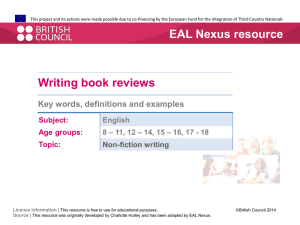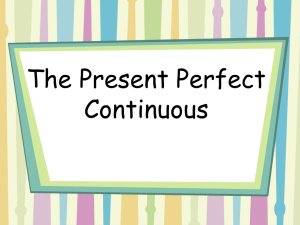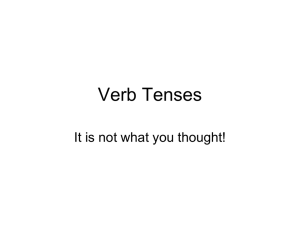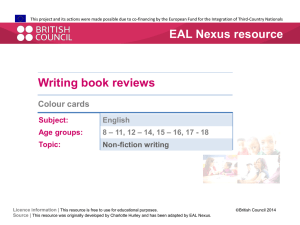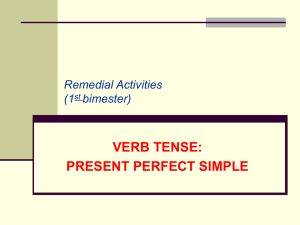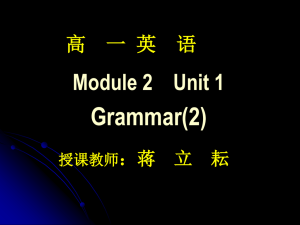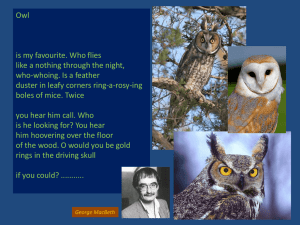Grammar Basics - School of Social Work
advertisement
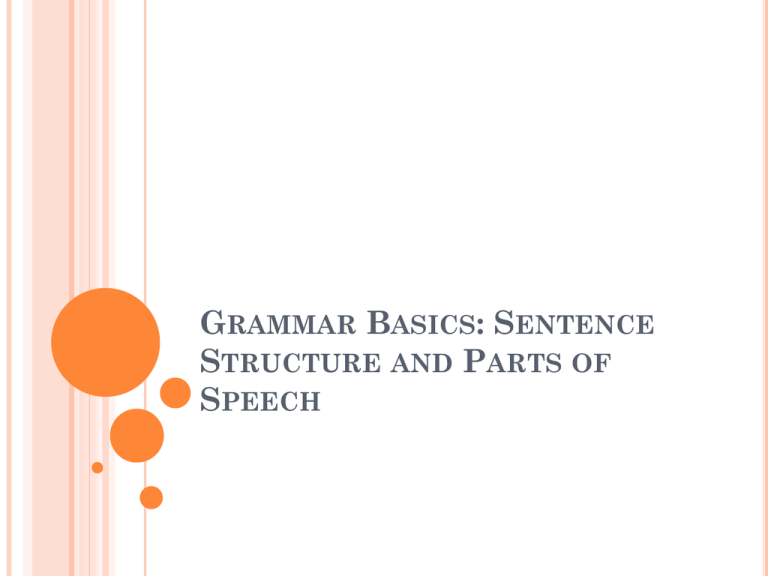
GRAMMAR BASICS: SENTENCE STRUCTURE AND PARTS OF SPEECH PARTS OF SPEECH 1. Verb: action (examine, illustrate, argue) Example: The author evaluates interview techniques. 2. Noun: person, place or thing (theory, child, agency, author) Example: The author evaluates interview techniques. 3. Pronoun: replaces a noun (he, she, you, I some) Example: He evaluates the interview techniques. PARTS OF SPEECH 4. Adjective: describes a noun (useful, good, interesting) Example: The study is interesting. This interesting study helped me write my paper. 5. Adverb: describes a verb (well, badly, very really, slowly) Example: The interesting study was badly cited. PARTS OF SPEECH 6. Conjunction: joins clauses or sentences (and, but, for, nor, or, so, yet) Example: I wanted to eat dessert, but I was too full. 7. Preposition: links a noun to another word (in, on, to, by, etc.) Example: I waited for her, but she never came to the party. USING SEMI-COLONS IN LISTS Use semi-colons to separate lists that are “together but separate.” Semi-colons are used to join items in a list that already contains one or more commas. Example 1: The sandwich choices include tomato, bacon and lettuce; cheese, ham and lettuce; peanut butter and jelly. Example 2: John Taylor is survived by his son, Jack, of California; his daughter, June, of Oregon; his grandchild, Jill, also of Oregon. Semicolons: Punctuating joined clauses. Retrieved from http://www.grammar- quizzes.com/punc-semicolons.html COMPARISONS BETWEEN SEMI-COLONS AND COMMAS Semi-colons: The sandwich choices include tomato, bacon and lettuce; cheese, ham and lettuce; peanut butter and jelly. Commas: The sandwich choices were ham, cheese, lettuce and tomato. Semi-colons: The shirts were red, white and blue; aqua, yellow and white; purple, yellow, black. Commas: The flags were blue, aqua and purple. Semi-colons: John Taylor is survived by his son, Jack, of California; his daughter, June, of Oregon; his grandchild, Jill, also of Oregon. USING SEMI-COLONS TO CONNECT CLAUSES Use semicolons when the independent clauses are somehow related and need no coordinating conjunctions. Example 1: He couldn't go home; he was too angry at his roommate. Alternative Approach: You can also use a comma and a coordinating conjunction. Example 2: We are going to eat at the Italian place, and Jenny will meet us there. Semicolons: Punctuating joined clauses. Retrieved from http://www.grammar-quizzes.com/puncsemicolons.html SEMI-COLONS VERSUS COLONS Use colons to connect sentences that have a direct relationship. Example 1: After a sleepless night, the senator made her decision: she would not seek re-election. Example 2: Our mother had one rule: whenever you eat in her kitchen, wash your dish and put it away. Helpful hint: Notice that the first clause really only makes sense with the additional clause. Therefore, use semi-colons when the sentence only makes sense with the second clause. Use semicolons when there is a relationship, but both sentences make sense on their own. USAGE GUIDELINES: YOUR AND YOU’RE Your is a possessive pronoun, “your book” or “your car.” You’re is a contraction for “you are.” Example: Your book is at my house, and you’re going to have to come pick it up. Example: You’re not following your own rule about cleaning up after yourself. USAGE GUIDELINES: ITS OR I T ’S Its is a possessive pronoun, “its use” or “its problem.” It’s is a contraction for “it is” or “it has.” Example: Its use can be measured through a diagnostic test, but it’s not always accurate. Example: It’s not perfect but the paint in the can basically matches its sample. USAGE GUIDELINES: THERE, THEY’RE, OR THEIR There is a reference to a place, “let’s go there,” or a pronoun, “There is hope.” Their is a possessive pronoun, “their opinions” or “their bags.” They’re is a contraction for “they are.” “They’re going to Dearborn.” Example: There is no reason for their behavior except that they’re crazy. VERB TENSE 1. Judy saved thirty dollars. (past) Often students drop the “ed,” but you must always include it if the action happened in the past. 2. Judy will save thirty dollars. (future) 3. Judy has saved thirty dollars. (present perfect) 4. Judy had saved thirty dollars by the end of last month. (past perfect) 5. Judy will have saved thirty dollars by the end of this month. (future perfect) KEEPING CONSISTENT VERB TENSE General guideline: Do not shift from one tense to another if the time frame for each action or state is the same. Incorrect: About noon the sky darkened, a breeze sprang up, and a low rumble announces the approaching storm. Darkened and sprang up are past tense verbs; announces is present but should be past (announced) to maintain consistency within the time frame. Corrected: About noon the sky darkened, a breeze sprang up, and a low rumble announced the approaching storm. Verb tense consistency. Purdue OWL. Retrieved from http://owl.english.purdue.edu/owl/resource/601/04/ KEEPING CONSISTENT VERB TENSE 2. Incorrect: Yesterday we walk to school but later rode the bus home. Walk is present tense but should be past to maintain consistency within the time frame (yesterday); rode is past, referring to an action completed before the current time frame. Corrected: Yesterday we walked to school but later rode the bus home. VERB TENSE General guideline: Do shift tense to indicate a change in time frame from one action or state to another. 1. The children love their new tree house, which they built themselves. Love is present tense, referring to a current state (they still love it now;) built is past, referring to an action completed before the current time frame (they are not still building it.) Verb tense consistency. Purdue OWL. Retrieved from http://owl.english.purdue.edu/owl/resource/601/04/ VERB TENSE 2. Workers are installing extra loudspeakers because the music in tonight's concert will need amplification. Are installing refers to an ongoing action in the current time frame (the workers are still installing, and have not finished;) will need is future, referring to action expected to begin after the current time frame (the concert will start in the future, and that's when it will need amplification.) Verb tense consistency. Purdue OWL. Retrieved from http://owl.english.purdue.edu/owl/resource/601/04/ VERB TENSE IN SOCIAL SCIENCE WRITING General guideline: Establish a primary tense for the main discourse, and use occasional shifts to other tenses to indicate changes in time frame. Use present tense to state facts, to refer to perpetual or habitual actions, and to discuss your own ideas or those expressed by an author in a particular work. Rely on past tense to narrate events and to refer to an author or an author's ideas as historical entities. (This is appropriate when citing a theory that was founded at a specific, definite time in the past.) Future action may be expressed in a variety of ways, including the use of will, shall, is going to, are about to, tomorrow and other adverbs of time, and a wide range of contextual cues. WHEN TO USE ARTICLES Articles are the words “a, an and the” that accompany nouns. The dog jumped in the car and brought a bone. Nouns that don’t need articles Proper nouns are specific people, places or things. This includes names of specific theories. Incorrect: Cat needs to be feed. Correct: Fluffy needs to be feed. WHEN TO USE ARTICLES Plural Nouns can go without articles. You can say cats or you can say the cats. Mass Nouns are nouns that are uncountable. These are often ideas like “information.” You could say “I need information.” Or, “I need the information.” WHEN IN DOUBT USE AN ARTICLE Very often students will drop the article from the beginning of the sentence. Incorrect: Location was a place where women could get job training. Correct: The location was a place… Incorrect: Interview gave me insight into the profession. Correct: The interview gave me insight… When to use articles before nouns. Grammar Girl. Retrieved from http://grammar.quickanddirtytips.com/articles-before-nouns.aspx REFERENCES Grammar Girl. (2010). When to use articles before nouns. Grammar Girl. Retrieved from http://grammar.quickanddirtytips.com/articlesbeforenouns.aspx Purdue Online Writing Lab. (2012). Verb tense consistency. Purdue OWL. Retrieved from http://owl.english.purdue.edu/owl/resource/601/04/ Sevastopoulos, J. (2012). Semicolons: Punctuating joined clauses. Grammar-Quizzes.com. Retrieved from http://www.grammar quizzes.com/punc-semicolons.html

